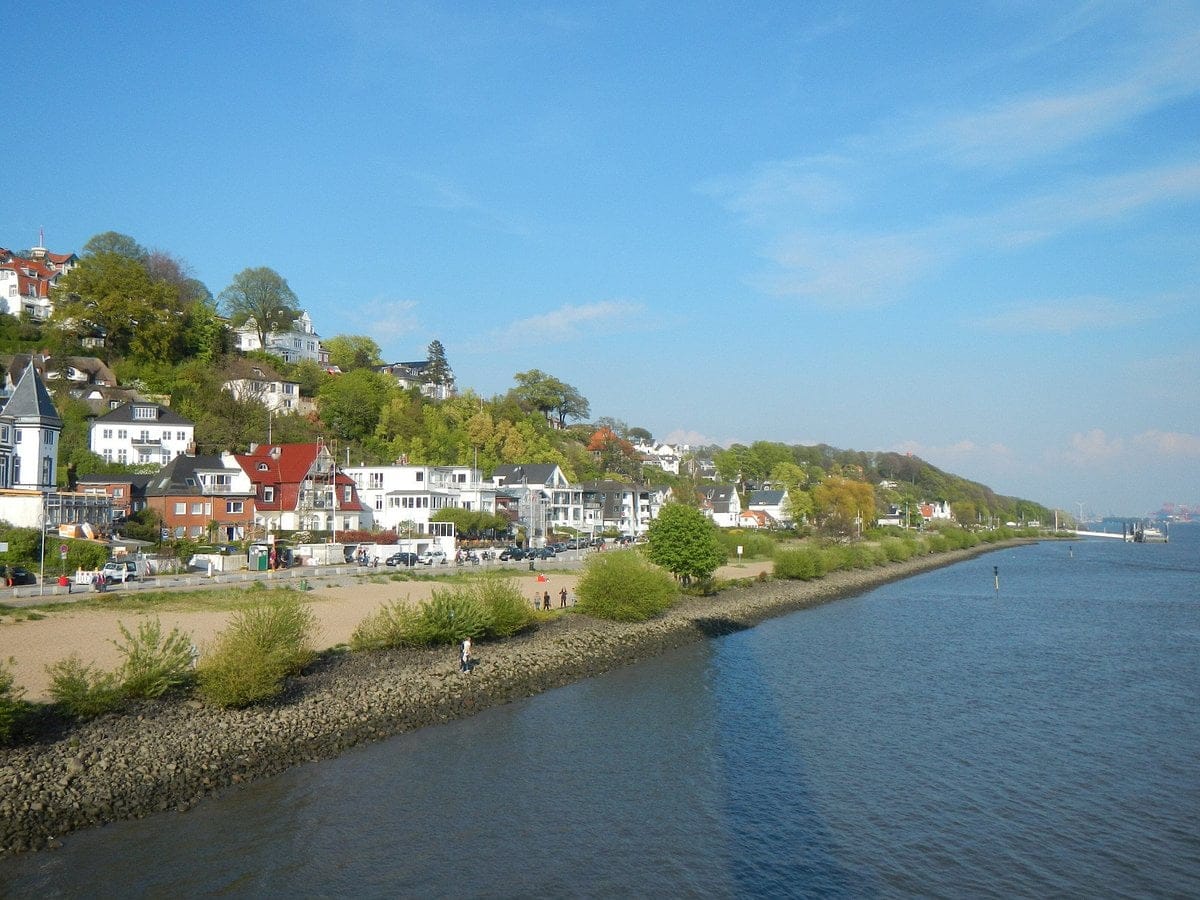Planning a trip to Central Europe and dreaming of a refreshing dip in the Elbe River? Before you grab your swimsuit, let’s dive into the realities of this majestic waterway. While the Elbe’s beauty is undeniable, its suitability for swimming is a bit more complicated.
Can You Swim in the Elbe River?
The Elbe River, while scenic, presents some challenges for swimmers. Strong currents, particularly in certain stretches, can pose a risk even for experienced swimmers. Additionally, the Elbe is a major shipping route, and large vessels navigating its waters create potential hazards for swimmers.
However, this doesn’t mean you can’t enjoy the Elbe up close. Designated swimming areas along the river offer safer alternatives. These areas are often marked and may even have lifeguards during certain times, providing a more controlled environment for swimming.
For those who prefer to stay dry, the Elbe offers a wealth of other ways to connect with its beauty. The river teems with wildlife, and numerous protected areas provide glimpses of diverse species. Cycling along the Elbe Cycle Route or embarking on a scenic drive along its banks offers stunning views and a chance to soak in the surrounding landscapes. Boat tours provide a unique perspective of the river, allowing you to appreciate its grandeur and historical significance from a comfortable distance.
Is the Elbe River Clean?
The Elbe River’s cleanliness is a topic of ongoing discussion and research. While significant strides have been made in pollution control over the years, the Elbe faces challenges common to many major rivers. Runoff from agricultural areas, industrial discharge, and wastewater treatment can all impact water quality.
It’s important to note that the Elbe’s water quality can vary depending on the location and time of year. Upstream areas, closer to the river’s source, generally exhibit better water quality than downstream stretches that may be influenced by human activities.
Scientists and environmental organizations continuously monitor the Elbe’s water quality, assessing factors like bacterial levels and pollutant concentrations. Their findings inform policies and initiatives aimed at improving the river’s health and ensuring its ecological integrity.
While swimming in the Elbe might not be advisable in all areas, it’s crucial to remember that the river is a vital ecosystem supporting a rich diversity of life. Protecting its waters and promoting sustainable practices are essential for preserving its beauty and ecological value for future generations.
How Deep is the Elbe River?
The Elbe’s depth, much like its cleanliness, is not one-size-fits-all. It fluctuates along its course, influenced by factors like the riverbed’s shape, the volume of water flowing through, and even the presence of dams or sandbars.
Near Magdeburg, Germany, the Elbe reaches its deepest point—a depth of around 23 feet (7 meters). In contrast, the river’s upper stretches, where it begins its journey, are shallower as the water flows over rocky, uneven terrain.
On average, the Elbe maintains a depth of about 8 feet (2.5 meters), sufficient for the passage of smaller boats and barges. However, this depth is not constant and can change due to various factors.
Monitoring the Elbe’s depth is crucial for navigation safety and flood control. Authorities and researchers constantly track water levels to ensure the safe passage of vessels and to anticipate potential flooding events.
Why is the Elbe River Famous?
The Elbe River’s fame stems from a captivating blend of natural beauty, ecological significance, and historical weight. Here’s a closer look at what makes it so special:
- UNESCO Recognition: The Elbe River Landscape holds the prestigious title of a UNESCO Biosphere Reserve, acknowledging its global importance for both natural and cultural heritage.
- Ecological Haven: The Elbe River provides a vital habitat for a diverse array of plant and animal species. Some of these, including endangered species, rely on the river’s ecosystem for their survival.
- Recreational Paradise: For those seeking outdoor adventures, the Elbe River doesn’t disappoint. Boating, kayaking, cycling along its banks, hiking in the nearby countryside—the options are as diverse as the river itself.
- Historical Significance: As a long-standing trade route, the Elbe River has witnessed centuries of history. Exploring the towns and cities along its banks offers glimpses into the past and the river’s role in shaping the region.Intrigued and want to learn more? The UNESCO World Heritage Centre’s website offers a wealth of information about the Elbe River Landscape:
[Citation: UNESCO World Heritage Centre. (2023). Elbe River Landscape. https://whc.unesco.org/en/list/843]
Is the Elbe River Navigable Now?
The Elbe River, even with its fluctuating water levels, remains a navigable waterway. However, navigating its waters, especially for larger vessels, requires careful planning and an awareness of the river’s dynamic nature.
Water levels in the Elbe can be particularly variable during the summer months when higher temperatures and increased water usage contribute to lower flows. These fluctuations can impact the draft of ships, potentially affecting their ability to navigate certain sections of the river.
The German Weather Service (DWD) plays a vital role in providing real-time information on water levels. Before embarking on any river journey, it’s strongly recommended to check the DWD’s updates to stay informed about current conditions.
Cruise operators specializing in Elbe River journeys are well-versed in adapting to the river’s changing moods. Companies like Viking River Cruises are known for their flexibility, adjusting itineraries or offering alternative experiences if water levels impact planned routes.
Navigating the Elbe, despite its quirks, is an experience in itself. The river’s beauty and the historical sites dotting its banks make it a captivating journey.
Is It Safe to Swim in the Elbe?
The question of swimming in the Elbe is not a simple yes or no. While the river may appear inviting, especially on a warm day, several factors suggest caution is warranted.
The Elbe’s strong currents, a defining characteristic of the river, pose a significant risk to swimmers. These currents can be unpredictable and much stronger than they appear from the surface, potentially overwhelming even strong swimmers.
Furthermore, the Elbe’s popularity as a shipping route adds another layer of concern. Large vessels, including cargo ships and barges, traverse the river, making it crucial for swimmers to be aware of their surroundings and exercise extreme caution.
While designated bathing areas exist along the Elbe, providing seemingly controlled environments for swimming, these areas may not be entirely free from risks. Water quality can vary depending on factors like rainfall and runoff, and swimmers should always check local advisories before entering the water.
For those seeking aquatic adventures, safer alternatives to swimming in the Elbe abound. Boating and kayaking offer opportunities to experience the river’s beauty while minimizing risks. The Elbe’s charm lies not only in its waters but also in the picturesque landscapes and historical sites that line its banks.
Ongoing Research: Scientists continue to study rivers like the Elbe to better understand water quality dynamics and the long-term impacts of pollution. As new research emerges, our understanding of the Elbe and its suitability for swimming may evolve.
Want to learn more? Organizations like the World Wildlife Fund and local environmental groups offer resources about the Elbe River and ways to contribute to its protection.
What is the Problem with the Elbe River?
The Elbe River, like many major waterways, faces challenges that impact its ecological health and suitability for certain activities, including swimming. Two primary concerns come to the forefront:
- Strong Currents: The Elbe’s currents, known for their strength and unpredictability, make swimming risky. Even experienced swimmers can find themselves at the mercy of these currents, highlighting the importance of caution.
- Water Quality: While efforts to improve the Elbe’s water quality have shown progress, pollution remains a concern. Runoff from agricultural areas, industrial discharge, and wastewater can all affect the river’s cleanliness, impacting its safety for swimming and the health of its ecosystem.
Despite these challenges, the Elbe remains a vital waterway, and efforts to address its problems and protect its health are ongoing.
Is the Elbe Clean?
The Elbe River’s cleanliness is a subject of ongoing efforts and gradual improvement. While it’s not typically considered among the cleanest rivers globally, significant strides have been made in recent decades to address pollution and enhance water quality.
One of the main challenges the Elbe faces is its role as a major transportation route. The Rhine River, another significant European river, also grapples with similar issues as it flows through several countries. The constant traffic of ships, while crucial for trade and commerce, can contribute to pollution through accidental spills, discharge of ballast water, and engine emissions.
Another factor impacting the Elbe’s cleanliness is its position within a heavily industrialized region. Industries located along the river’s banks, while contributing to the economy, can also release pollutants into the water, even with regulations in place.
Despite these challenges, efforts to clean up the Elbe River have gained momentum in recent years. Germany, in particular, has invested heavily in wastewater treatment plants and implemented stricter environmental regulations for industries operating near the river.
Which is the Cleanest Water River in the World?
Crowning a single river as the “cleanest” is a tricky endeavor. Water quality is influenced by a complex interplay of factors, including geography, climate, and human activities, making comparisons challenging.
Rivers often cited for their exceptional water quality include:
- The Methow River (Washington, USA): Flowing through a largely pristine mountainous region, the Methow River is renowned for its clarity and purity.
- The Buffalo National River (Arkansas, USA): Protected within a national park, the Buffalo National River benefits from conservation efforts and limited development, contributing to its high water quality.
- The Skagit River (Washington, USA): Fed by glaciers and flowing through a relatively undeveloped watershed, the Skagit River boasts excellent water quality.
Determining a river’s “cleanliness” involves assessing various factors like:
- Dissolved Oxygen: Adequate dissolved oxygen levels are essential for aquatic life, and low levels can indicate pollution.
- Bacteria Levels: The presence of harmful bacteria, often from sewage or animal waste, can pose risks to human health and indicate poor water quality.
- Nutrient Levels: Excessive nutrients, like nitrogen and phosphorus, can lead to algal blooms that deplete oxygen and harm aquatic life.
The National Rivers and Streams Assessment (NRSA) in the United States and similar programs worldwide play a crucial role in monitoring river health and providing data to guide conservation efforts.
What is the Cleanest River in the United States?
The title of “cleanest river in the United States” is often bestowed upon the Methow River, a pristine waterway meandering through the North Cascades region of Washington State. Its remarkably clear waters, fed by snowmelt and flowing through a sparsely populated area, contribute to its reputation for exceptional quality.
However, several other contenders consistently rank highly in water quality assessments. The Buffalo National River, winding through the Ozark Mountains in Arkansas, benefits from its protected status within a national park. The Skagit River, also in Washington, earns recognition for its pristine waters originating from glaciers and traversing a relatively undeveloped watershed.
Pennsylvania’s Clarion River and the St. Croix River, shared by Wisconsin and Minnesota, also deserve mention for their high water quality.
Assessing and comparing river cleanliness involve examining a range of factors:
- Dissolved Oxygen: Crucial for aquatic life, dissolved oxygen levels indicate the water’s ability to support healthy ecosystems.
- Turbidity: Turbidity measures water clarity, with lower turbidity indicating cleaner water.
- Nutrient Levels: Excessive nutrients, often from agricultural runoff or wastewater, can fuel algal blooms that harm water quality.
The National Rivers and Streams Assessment (NRSA) conducts comprehensive assessments of the nation’s waterways, providing valuable data to inform conservation efforts and track changes in water quality over time.
What is the Cleanest Major River in Europe?
Pinpointing the absolute cleanest major river in Europe is a challenging task, as water quality can fluctuate and comprehensive data for every river is not always readily available.
However, some rivers often recognized for their relatively good water quality include:
- The Torne River (Sweden/Finland): Flowing through a sparsely populated region, the Torne River benefits from minimal human impact, contributing to its high water quality.
- The Vindel River (Sweden): Protected as a UNESCO World Heritage Site, the Vindel River remains largely free-flowing and boasts excellent water quality.
- The Soča River (Slovenia/Italy): Known for its emerald-green waters, the Soča River flows through a scenic and relatively pristine region.
It’s important to note that even rivers renowned for their cleanliness can experience localized pollution or seasonal variations in water quality. Factors like rainfall patterns, agricultural practices, and industrial activities can all influence a river’s cleanliness.
- China II Review: Delicious Food & Speedy Service - April 17, 2025
- Understand Virginia’s Flag: History & Debate - April 17, 2025
- Explore Long Island’s Map: Unique Regions & Insights - April 17, 2025

















2 thoughts on “Dive In or Steer Clear? The Truth About Swimming in the Elbe River”
Comments are closed.